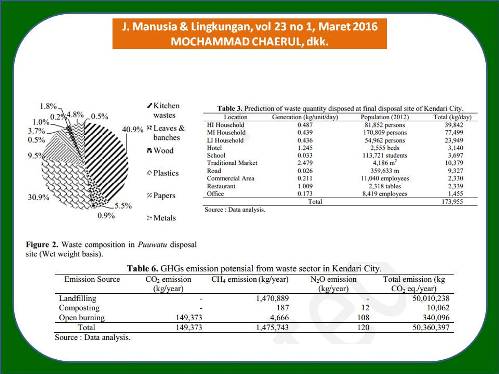
PREDICTION OF GREENHOUSE GASSES EMISSION FROM MUNICIPAL SOLID WASTE SECTOR IN KENDARI CITY, INDONESIA (Prediksi Emisi Gas Rumah Kaca dari Sektor Sampah di Kota Kendari, Indonesia)
Mochammad Chaerul(1*), Gan Gan Dirgantara(2), Rangga Akib(3)
(1) Faculty of Civil and Environmental Engineering, Institut Teknologi Bandung, Jalan Ganesha No. 10 Bandung 40132.
(2) Deutsche Gesellchaft fur Internationale Zusammenarbeit (GIZ), Menara BCA 46th FI, Jalan MH. Thamrin No. 1 Jakarta 10310.
(3) Deutsche Gesellchaft fur Internationale Zusammenarbeit (GIZ), Menara BCA 46th FI, Jalan MH. Thamrin No. 1 Jakarta 10310.
(*) Corresponding Author
Abstract
ABSTRAK
Municipal solid waste sector is considered as one of major contributors for Greenhouse Gasses (GHGs). GHGs that are CO2, CH4 and N2O were emitted from any waste management stages including waste transportation, treatment and disposal. The paper aims to predict GHGs emission from the last two stages above using the guidelines issued by Intergovernmental Panel on Climate Change (IPCC) year of 2006. By comparing amount of waste generation at source and waste comes to landfill site, it can be found that the municipality only transport 68% of total 174 ton/day waste generated throughout the city. Percentage of waste to be composted and openly burned were 3.25 and 0.06 % of total waste generated, respectively. Organic waste, plastics and paper were dominantly found at final disposal site by 41, 31 and 9 %, respectively. GHGs emission from landfilling becomes a major source and it equals to 50,010 ton CO2 equivalent/year. The second largest of GHGs generator is waste burning equals to 340 ton CO2 equivalent/year. While waste composting generates 10 ton CO2 equivalent/year. Amount of GHGs emission can be reduced by reducing amount of waste to be landfilled and improving better practice at final disposal. Further, any measures regarding with Reduce, Reuse and Recycling (3R) of waste becomes important to be improved to reduce GHGs emission.
ASBTRACT
Sektor sampah merupakan salahsatu penyumbang utama Gas Rumah Kaca (GRK). GRK meliputi CO2, CH4 and N2O diemisikan dari berbagai tahapan pengelolaan sampah, termasuk pengangkutan, pengolahan dan penimbunan sampah. Paper ini bertujuan untuk memprediksi emisi GRK dari dua tahapan terakhir dengan menggunakan panduan yang dikeluarkan oleh Intergovernmental Panel on Climate Change (IPCC) tahun 2006. Dengan membandingkan jumlah timbulan sampah di sumber dan yang sampai di lokasi Tempat Pemrosesan Akhir (TPA) sampah, dapat diketahui bahwa pemerintah daerah hanya dapat mengangkut 68% dari total timbulan sampah Kota Kendari di sumber yang sebesar 174 ton/hari. Jumlah sampah yang dikomposkan dan dibakar terbuka masing-masing sebesar 3,25 dan 0,06 %. Sampah organik, plastik dan kertas mendominasi jenis sampah di TPA dengan prosentase masing-masing 41, 31 dan 9 %. Emisi GRK dari penimbunan sampah menjadi sumber terbesar yaitu sebesar 50.010 ton CO2 ekuivalen/tahun. Sumber terbesar kedua adalah pembakaran sampah yang sebesar 340 ton CO2 ekuivalen/tahun. Sementara pengomposan mengemisikan 10 ton CO2 ekuivalen/tahun. Jumlah emisi GRK dapat direduksi dengan cara mengurangi jumlah sampah yang ditimbun dan memperbaiki pengoperasian penimbunan yang lebih baik. Lebih lanjut lagi, berbagai macam kegiatan yang berhubungan dengan implementasi konsep Reduce, Reuse dan Recycling (3R) dalam pengelolaan sampah menjadi penting untuk ditingkatkan dalam rangka mengurangi emisi GRK.
Keywords
Full Text:
Artikel lengkap (PDF) (Bahasa Indonesia)References
Anonymous. 2011. Laporan Studi Inventarisasi Gas Rumah Kaca dari Sektor Persampahan. Ministry of Environment, Jakarta.
Anonymous. 2013. Kendari dalam Angka 2013. Badan Pusat Statistik Kota Kendari.
Akhtar, H., and Soetjipto, H.P., 2014. Peran Sikap dalam Memediasi Pengaruh Pengetahuan terhadap Perilaku Minimasi Sampah pada Masyarakat Terban, Yogyakarta. Jurnal Manusia dan Lingkungan, 21(3):386-392.
Aprilia, A., and Tezuka, T., 2013. GHGs Emissions Estimation from Household Solid Waste Management in Jakarta, Indonesia. Journal of Energy and Power Engineering, 7(1):661-668.
Chen, T.C., and Lin, C.F., 2008. Greenhouse Gases Emissions from Waste Management Practices using Life Cycle Inventory Model. Journal of Hazardous Materials, 155(1):23–31.
Johari, A., Ahmed, S.I., Hashim, H., Alkali, H., and Ramli, M., 2012. Economic and Environmental Benefits of Landfill Gas from Municipal Solid Waste in Malaysia. Renewable and Sustainable Energy Reviews, 16(5):2907–2912.
Philippe, F.X., and Nicks, B., 2015. Review on Greenhouse Gas Emissions from Pig Houses: Production of Carbon Dioxide, Methane and Nitrous Oxide by Animals and Manure. Agriculture, Ecosystems and Environment, 199(1):10-25.
Pipatti, R., and Vieira, S.M., 2006. IPCC Guidelines for National Greenhouse Gas Inventories for Waste Sector. WMO, Geneva
Purwanto, W., 2009. Perhitungan Gas Rumah Kaca dari Sektor Pengelolaan Sampah di Indonesia. Jurnal Teknologi Lingkungan, 10(1):1-8.
Tan, S.T., Hashim H., Lim, J.S., Ho, W.S., Lee, C.T., and Yan, J., 2014. Energy and Emissions Benefits of Renewable Energy Derived from Municipal Solid Waste: Analysis of a Low Carbon Scenario in Malaysia. Applied Energy, 136 (4):797-804.
Tchobanoglous, G., Theisen, H., and Vigil, S.A., 1993. Integrated Solid Waste Management. McGraw-Hill International, Singapore.
Zuberi, M.J.S., and Ali S.F., 2015. Greenhouse Effect Reduction by Recovering Energy from Waste Landfills in Pakistan. Renewable and Sustainable Energy Reviews, 44(1):117-131.
Article Metrics
Refbacks
- There are currently no refbacks.
Copyright (c) 2017 Jurnal Manusia dan Lingkungan







